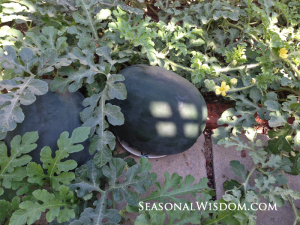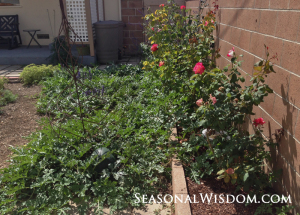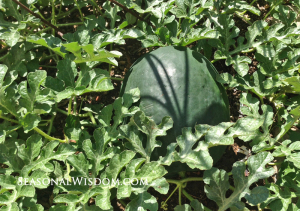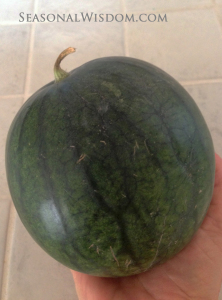 However you slice them, watermelons are delicious and nutritious fruit to feature in your kitchen and garden. Best of all, this fruit can be easy to grow if you pay attention to a few gardening guidelines. Shown above are two ‘Black Diamond’ watermelons almost ready to harvest at my home.
However you slice them, watermelons are delicious and nutritious fruit to feature in your kitchen and garden. Best of all, this fruit can be easy to grow if you pay attention to a few gardening guidelines. Shown above are two ‘Black Diamond’ watermelons almost ready to harvest at my home.
Learn some of my favorite tips for growing and harvesting watermelons.
My watermelon garden did great this year, and I’m excited about the results. Typically, coastal California isn’t the best place to grow watermelons, but here are some reasons why these warm-season fruits grew so well:
Hot Weather
- We usually have cool summers with foggy mornings at the beach. But this year has been hot and humid, often reaching temperatures of 80s and 90s. That’s the kind of weather that watermelons love. (Those of us without air conditioners are a little less thrilled.)
- Plant your watermelons after the last frost date, when soil temperatures reach at least 70 degrees F. Even a light freeze can kill a watermelon plant. Watermelons need full sun, or at least six hours of sunlight daily.
- Have a short and cold growing season? Most watermelons require anywhere from 80 to 95 days to ripen, sometimes longer, depending on the variety. Start your seeds indoors about a month before the last frost date, and then transplant outdoors when warm enough. Or, buy established plants and use black plastic mulch that will warm up the soil more quickly. Also, try growing in raised beds for better drainage and warmer soil.
Healthy Soil
- I had just built this garden bed, and had tilled in lots of compost into the top five inches of the soil. This amended soil had excellent drainage, which made these watermelons thrive.
- Plant your watermelons in soil that has been well-amended with compost or well-aged manure.
- Add organic, well-balanced fertilizer, and follow the directions carefully.
 Lots of Room
Lots of Room
- Watermelons need plenty of room to ramble, and it’s not uncommon for plants to grow vines that are 20 feet long. Above is a photo of one ‘Black Diamond’ watermelon plant that took over this side of my garden. Consider yourself warned!
Watering Watermelons
- Keep soil moist when the plants are starting off, and until the watermelons start forming about the size of a tennis ball. Experts then recommend you water only when the soil is dry, and especially cut back on your watering right before harvest. This concentrates the sugars in the fruit.
- Water at the roots, and avoid wetting the foliage to mitigate fungal diseases. We’re in a drought here, so I’ve used water from my two rain barrels. I’ve also saved water in the shower, while the water was heating up. ‘Black Diamond’ is said to be a rather drought tolerant variety too.
 Harvesting Watermelons
Harvesting Watermelons
Watermelons can be a little tricky to determine when they are ripe. Picking them at the right time is important, because watermelons stop ripening once they are picked.
Here are some tips for knowing when to harvest watermelons:
- Keep track of the time your variety takes to ripen. This information is often on the seed package or plant label. Mark it on your calendar when you plant, so you have a good idea when to look.
- Rap on the watermelon and listen for a low-pitched, hollow sound.
- Watch for the rind to change from a bright slick look to a more dulled appearance.
- See if the bottom spot on the ground turned from white to a rich yellow.
- Stick a thumbnail into the watermelon. The skin should be tough enough that your nail doesn’t cut through it.
- Watch for the closet tendril to the melon stem to turn brown. A grower at my farmers’ market shared this tip.
Don’t forget to leave an inch of stem when cutting your watermelon to prevent rotting if it sits awhile.
Watermelons should keep two or three weeks unrefrigerated. Keeping them in a cool place, however, will help them hold better. Always refrigerate any cut pieces of melon.
Watermelons are Nutritious
These sweet fruits might be 92 percent water, but watermelons still have vitamins A, B6, C and thiamine, not to mention traces of other nutrients. Watermelons are especially high in the antioxidant called lycopene, which is believed to help prevent certain cancers and heart disease.
Try your watermelons straight with a little salt. Or, blend and freeze melons for delicious popsicles. My favorite way to eat watermelons is in a salad with chopped red onions, feta cheese, mint leaves and vinaigrette. It’s especially delightful on a hot summer day.
Watermelon Varieties
Below are just two of the many different watermelons available to grow:
‘Sugar Baby’ Watermelon (6 to 10 pounds) is small enough to fit in your hand, and is convenient for your ice box. This one ripens in around 78 days.
 ‘Black Diamond’ Watermelon (35 to 50 pounds, even larger) will need about 90+ days to ripen.
‘Black Diamond’ Watermelon (35 to 50 pounds, even larger) will need about 90+ days to ripen.
The 1956 Henry Field’s Seed Co. seed catalog said about this watermelon, “The big, round, dark green one you find in all markets. Flesh crisp, very flavorful and sweet.”
Today, these heirlooms are more difficult to find in the market, so try growing your own.











Comments on this entry are closed.